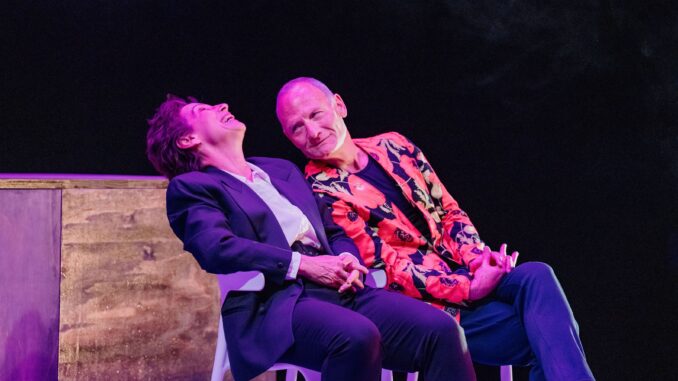
[How Not to Survive a Plague]
Why do some people move through the world with more ease than others? It’s something I think about a lot. A lack of trauma or baggage, I suppose. So what happens to a man who is a bundle of tightly wound trauma? Well, the expectations of dramatic narrative say we pull him apart and let him unravel.
And that’s effectively what happens in Everything After. We witness our protagonist Nick (Simon Prast), HIV/AIDS activist and survivor, challenged over and over to survive the treacherous banalities of modern gay life. He is the beating heart of the play, a lone island with so much history surrounding him like water. A character not with a fatal flaw in that tragic Greek sense. No, just the human one of wanting to be loved, to wanting to carve a space in the world, but ultimately being displaced.
There are few plays in our country’s queer canon. And there are fewer plays in our queer canon that celebrate the experiences of older gay men living with HIV. In Everything After, playwright and director Shane Bosher contributes to the canon by taking the AIDS play and thrusting it into our contemporary age. It’s incredible that the play is such an anomaly, but it is.
And if there’s anyone qualified to tackle this subject matter, Bosher would be the one. With a back catalogue of directing gigs that cover gay classics such as Holding the Man to Angels in America, and contemporary dramas such as Cock and Homos, writing his own tale feels like the logical next step. It feels cut from the same cloth as many of these plays, playing like a heartfelt homage, with grandaddy of the genre Larry Kramer (Normal Heart) looming over front and centre.
In a way, Everything After is a collection and celebration of Bosher’s favourite tropes and favourite actors. We have sweeping monologues recalling a forgotten time. There are delicious two-hander scenes staged with precise choreography. There’s even a moment where the stage transforms in an unexpected way. It treads familiar territory to all these things while also giving a fresh modern spin.
Bosher directs the play with his signature slickness. Everything is tightly stitched together, transitions blending seamlessly, even when the demands of the scene require a filmic touch. Dan Williams’ utilitarian set design, consisting of a modernist kitchen bench and versatile rostrum supports these shifts. Sean Lynch’s lighting shifts offer subtle changes as well as more stunning stylized moments. The percussive sound design by Paul McLaney is the final touch punctuating swift changes, as well as heightening moments of intimacy into something more operatic.
In a demanding lead role as Nick, Simon Prast is rarely ever off-stage. It’s a challenging part, one where he shines in being charismatic as we see the glimmer of the old activist. He’s utterly believable as someone who has lived a profoundly hard life but lived to tell the tale. The difficult side of the role is playing someone who is a victim of circumstance and something of a martyr. I don’t always buy the character arc, but it’s hard to take your eyes off.
As Mary, Alison Bruce is the other star of the play, hero in her own right. Performed magnificently by Bruce, she’s the much needed light in the second darker half. Bruce brings an equally lived in quality to the performance. It’s the sort of role she can play blindfolded, but that doesn’t make it any less impressive.
Matt Minto might have the most difficult task as the love interest, demanding we fall in love with him and root for a relationship that is built very quickly. The arc of the relationship mostly occurs offstage, with only the top and tail left for us to digest. The early meet-cute of the relationship is performed with easy charm but feels reduced to a plot device when asked to pivot in a darker direction.
Stephen Lovatt spends most of the play delivering a series of poetic monologues with an easefulness that softens the expository nature of them. They’re full of backstory and important context, but occasionally veer towards a density and didacticism I find myself disengaging with.
Simon Leary plays the smug homosexual well, channeling gentrification into every bone of his body. Less a character and more an ideological opponent, he’s a stand in for the often sterile sausage-making of bureaucracy and political work.
Playing multiple roles, Arlo Green is given the most room to flex. He is asked to move from performative masculinity to some deliberately camp caricatures that he manages with a wide range of scope. Not always as grounded as the other performances, it can be a jarring and uneasy fit with the rest of the play. There’s something about these scenes that hark to the sensibility of the 90s, like something ripped out of a Mark Ravenhill play or an Irvine Welsh novel.
With that said, it does feel strange that a play in tribute of queer bodies is performed by many bodies without the necessary lived experience. It’s only occasionally distracting, but when a character complains about straight-acting gay men, I can’t help but notice the presence of gay-acting straight men in the cast.
A biting wit peppers the script well, and this is where Bosher’s observations work best. In the mundane and tragicomic aspects of modern life. From the chopping of onions to the couches in porn, these jokes soften us to the play. In the play’s earliest and sharpest scene, we see Nick working through a sex survey with a patient getting their STI test. It’s a great demonstration of all the things we should admire in Nick, as well as his fire. And it shows him in control as well as deeply caring.
The metaphor the play uses to explain the AIDS epidemic is one of war. Unlike most war heroes though, Nick’s only badges of service are memories that haunt him to this day. It’s a realistic portrayal. Throughout the play Nick is given hope and then that hope is pulled from under him. It’s a punishing story arc to witness a character go through. And here is where the play stops short of moving me.
As an exercise in pure melodrama it’s highly watchable, even if I find myself watching it with a level of remove. Occasionally it feels like a box-ticking exercise in the ways that modern gay culture can go off like sour milk: dating apps, heternormativity, bareback sex, infidelity, seroconversion, drug abuse. There’s an uneasy tension between the presentation of realism and the didacticism of the content, though a tension I feel Kramer himself would admire. A similar tension between the play’s nihilism and it’s compassion also fuels the second half. It’s these polarities that the play hints towards that I find most interesting to watch unfold and bump up against each other.
The play’s many threads are all substantial and worthy of their own play. The indictment of heteronormative gay corporations. The tentativeness of new romance in old age. A look at the dark underbelly of chemsex. The friendship between survivors of the AIDS crisis. In juggling so many plotlines, the play never quite lands on any single one. Instead, Bosher frames these many storylines to paint a picture of the factors that lead to pushing a single man over the edge. I leave the play pitying Nick, when what I want to leave with is a deep sense of admiration for him. I want to be fired up by his anger, but I only feel his flame snuffed out.
If I make it sound completely bleak, that isn’t always the case. If anything, the first half of the play is suffused with an abundance of warmth and humour. We witness time and time again characters showing and sharing moments of vulnerability. It’s a real treat experiencing carefully crafted scenes of intimacy on the big stage. And, with support from intimacy coordinator Robbie-Taylor Hunt, there are few directors who can do it better.
The narrative demands we never forget the horrors of the AIDS crisis. That we are still living in the wreckage of that crisis. It’s not subtle, and it doesn’t pretend to be, especially as the play veers towards pure melodrama in the second act. It’s a pretty taxing catalogue of gay male trauma. The play’s subject matter, much like its character, is fighting for relevance in a culture that seems to have moved on quickly. If the Normal Heart felt timely and urgent warcry because of its proximity to the AIDS crisis itself, Everything After is a heavy sigh long after the war is over. What happens to its soldiers when the war is over? This isn’t a play set in a historical moment in time, but the long ongoing aftermath, where you are expected to move on. This tragic irony tinges the play. The irony of being an AIDS survivor during an era where bareback sex and preventative medication is in abudance.
In many ways the play is rather damning. It points a finger at a current generation of gay men who have forgotten that pride was paved from pain. I do think this is exactly the sort of play Larry Kramer himself might have imagined had he attempted to wrestle with writing something for the present moment. In many ways it is the antithesis of Angels in America, it leaves us not with hope but stranded in a wasteland. The final image is a strikingly biblical one, begging us to take responsibility and hold onto history. I don’t agree with the way this message is conveyed but it does feel essential. A flawed but significant addition to our queer canon.
Everything After plays Q Rangatira 2-18 July, 2021.




Leave a Reply